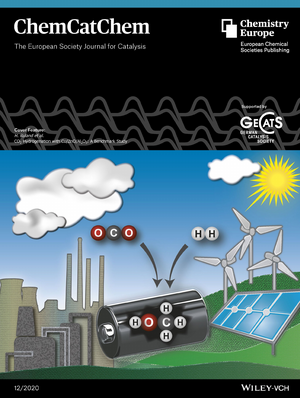A research paper by Dr. Holger Ruland and his team has been published as a cover story in the latest issue of the journal ChemCatChem.
The Cover Feature shows the concept of CO2 hydrogenation as a chemical battery in the scope of a chemical energy conversion. It can be used to store renewable energy by synthesizing methanol from H2 obtained from renewable energy sources and CO2 from industrial waste gases. Dr. Holger Ruland and a team of scientists from RUB and MPI CEC investigated the suitability of a commercial and industrially applied Cu‐based catalyst for the synthesis of methanol by CO2 hydrogenation.
In their research work they demonstrate the extraordinary stability and high performance of an industrial Cu/ZnO/Al2O3 catalyst for methanol production from feed gases with high CO2 concentrations. Especially, the catalytic system can work with a similar stability even under dynamic reaction conditions, which may be essential to integrate renewables into the process.
Original Publication: Ruland, H., Song, H., Laudenschleger, D., Stürmer, S., Schmidt, S., He, J., Kähler, K., Muhler, M., Schlögl, R. (2020). CO2 hydrogenation with Cu/ZnO/Al2O3: A benchmark study. ChemCatChem https://doi.org/10.1002/cctc.202000195 Cover Feature
Cover and paper published open access in ChemChatChem, 2020 Wiley-VCH Verlag GmbH & Co. KGaA, Weinheim doi.org/10.1002/cctc.202000195

